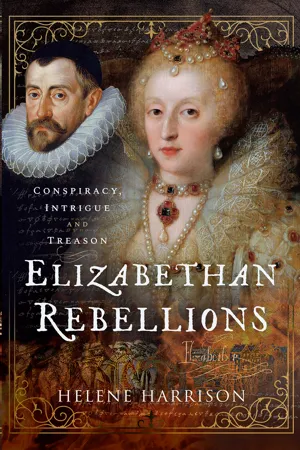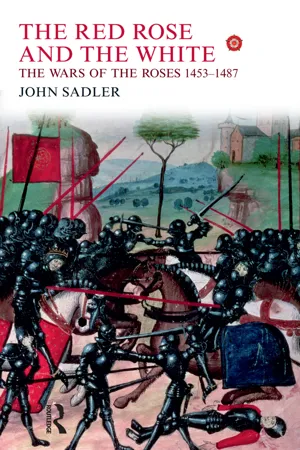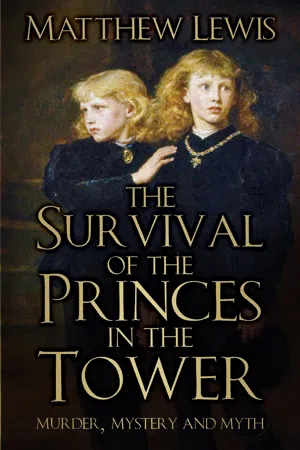History
Simnel Rebellion
The Simnel Rebellion was a 1487 uprising in England led by Lambert Simnel, who claimed to be the Earl of Warwick, a potential rival to King Henry VII. The rebellion was supported by Yorkist sympathizers who opposed Henry VII's rule. It culminated in the Battle of Stoke, where the rebels were defeated, and Simnel was captured and later pardoned by the king.
Written by Perlego with AI-assistance
Related key terms
Related key terms
1 of 4
Related key terms
1 of 3
5 Key excerpts on "Simnel Rebellion"
- eBook - ePub
Elizabethan Rebellions
Conspiracy, Intrigue and Treason
- Helene Harrison(Author)
- 2023(Publication Date)
- Pen and Sword History(Publisher)
An understanding of these earlier Tudor rebellions can help us to understand Elizabeth’s reactions to the rebellions that she had to deal with during her reign. Elizabeth herself was rumoured to be involved in the Wyatt Rebellion under her half-sister, Mary I, though nothing was ever proven. She was imprisoned in the Tower of London as a result and came close to execution. Her early experiences of rebellion shaped her own reactions when she had to deal with revolts against her own claim to the throne and controversial decisions she made.*The first major rebellion of the Tudor dynasty was under Henry VII in 1487 and concerned a young boy by the name of Lambert Simnel. Henry VII had only been on the throne for two years; and the Wars of the Roses were not known to be over as Henry VII could have just been another king who took the throne by force and could be overthrown at any moment. It is only with hindsight that we can see that the Wars of the Roses were effectively over, and that Henry VII had founded a dynasty that would reign for over a hundred years. There would not be another violent change of ruler until the English Civil War in the seventeenth century when England changed, temporarily, from a monarchy to a republic under Oliver Cromwell and Charles I was executed.The English people did not really know Henry VII. He had grown up in exile in France in the Duchy of Brittany where he had escaped to with his uncle, Jasper Tudor, Earl of Pembroke, and later 1st Duke of Bedford, in the aftermath of the Battle of Tewkesbury in 1471. Tewkesbury marked the defeat of the Lancastrian dynasty and the restoration of the Yorkist Edward IV to the English throne. It also marked the beginning of fourteen years of exile for the future Henry VII. Why is Henry VII’s exile important to the rebellions he struggled with during his reign? The English people did not really know much about him because he had not been in the country and the two major rebellions he had to tackle were to do with the succession and promoting candidates who were more well known in England: namely Richard, Duke of York, younger of the Princes in the Tower, and Edward Plantagenet, 17th Earl of Warwick.Lambert Simnel was a pretender. The surviving Yorkists believed that, if no Yorkist claimant to the throne existed, one had to be created.2 Simnel was the son of an Oxford man who pretended to be Edward, Earl of Warwick, son of George, 1st Duke of Clarence, and nephew to both Edward IV and Richard III. The real Warwick was born in 1475 so was aged 12 in 1487, and Simnel was said to be around aged ten. This would not necessarily have been a problem if Simnel looked older than his years, or it could be claimed that Warwick looked younger than his years due to his imprisonment in the Tower. Polydore Vergil reported that rumours spread of Warwick’s death in prison in 1487 and when the priest Richard Simons learned this, he changed Simnel’s name to Edward and crossed to Ireland, where many disaffected Yorkists had fled to after Bosworth.3 Simons spread a rumour that Warwick had escaped from the Tower and was under his guardianship. Yorkists claimed rather that they had rescued Warwick from the Tower themselves and brought him to Ireland.4 - eBook - ePub
The Red Rose and the White
The Wars of the Roses, 1453-1487
- John Sadler(Author)
- 2014(Publication Date)
- Routledge(Publisher)
6 briefly kept the flame flickering in Cumberland. Lovell managed to give the hounds the slip and made good his escape to Flanders. Henry now turned south and west to stamp out the embers of Stafford’s attempt. Sir Humphrey and his brother, Sir Thomas, again sought sanctuary, this time at Culham, by Abingdon. Their rebellion had raised no more followers than Lovell’s aborted attempt in the north, their faltering cause sustained by a poor mix of rumour and pious hopes. Henry had, however, had quite enough of Humphrey Stafford and, as the royal judges were later to find, the normal rules of sanctuary did not obtain in cases of high treason. Stafford lost his head, though Sir Thomas and the other, lesser malefactors were treated with leniency.Lambert Simnel
If men were losing their taste for armed conflict, factionalism, as Polydore Vergil later highlighted, once ingrained becomes a difficult trend to reverse. Richard Simons, a priest at Oxford, certainly seems to have thought so when he attempted to pass off one of his protégés as the young Earl of Warwick. This wretched and innocent youth had been the focus of Lovell and Stafford’s abortive rising, and the magic of the name created a handy focus for any mutterings of discontent. What is remarkable is how so many influential people found it expedient to believe him, as Vergil relates:At Oxford, where he devoted himself to scholarship, he brought up a certain youth who was called Lambert Simnel. He first taught he boy courtly manners, so that if ever he should pretend the lad to be of royal descent (as he had planned to do) people would the more readily believe it and have absolute trust in the bold deceit.7Henry had deemed it wise to parade the captive Earl, so-called, through the streets of the capital on 17 February 1486, to show that he had the young man safe and that, contrary to rumour, he had not been done to death in the Tower. Despite the patent implausibility of his claim, there were those who found it convenient to accept Father Simons’ protégé as the real Earl of Warwick. Chief amongst these was John de la Pole, Earl of Lincoln, who had been the most likely heir to Richard III after the death of Edward of Middleham. He had submitted, readily enough, to Henry Tudor in 1485 and appeared to have had no interest in the pretensions of Lambert Simnel until after February 1487. At this point he defected to Flanders where he made common cause with Richard III ’s sister, his own aunt, the dowager Duchess of Burgundy.8 In Ireland there was also disaffection, as Henry had refused to confirm Gerald Fitzgerald, 8th Earl of Kildare9 - eBook - ePub
- David Hume(Author)
- 2020(Publication Date)
- Vintage Books(Publisher)
Henry was not ignorant of these intentions of his enemies, and he prepared himself for defence. He ordered troops to be levied in different parts of the kingdom, and put them under the command of the duke of Bedford and earl of Oxford. He confined the marquis of Dorset, who, he suspected, would resent the injuries suffered by his mother, the queen dowager; and, to gratify the people by an appearance of devotion, he made a pilgrimage to our lady of Walsingham, famous for miracles; and there offered up prayers for success, and for deliverance from his enemies.Being informed that Simnel was landed at Foudrey in Lancashire, he drew together his forces, and advanced towards the enemy as far as Coventry. The rebels had entertained hopes that the disaffected counties in the north would rise in their favor; but the people in general, averse to join Irish and German invaders, convinced of Lambert’s imposture, and kept in awe by the king’s reputation for success and conduct, either remained in tranquillity, or gave assistance to the royal army. The earl of Lincoln, therefore, who commanded the rebels, finding no hopes but in victory, was determined to bring the matter to a speedy decision; and the king, supported by the native courage of his temper, and emboldened by a great accession of volunteers, who had joined him under the earl of Shrewsbury and Lord Strange, declined not the combat. The hostile armies met at Stoke, in the county of Nottingham, and fought a battle, which was bloody, and more obstinately disputed than could have been expected from the inequality of their force. All the leaders of the rebels were resolved to conquer or to perish; and they inspired their troops with like resolution. The Germans also, being veteran and experienced soldiers, kept the event long doubtful; and even the Irish, though ill-armed and almost defenceless, showed themselves not defective in spirit and bravery. The king’s victory was purchased with loss, but was entirely decisive. Lincoln, Broughton, and Swart perished in the field of battle, with four thousand of their followers. As Lovel was never more heard of, he was believed to have undergone the same fate; Simnel, with his tutor, Simon, was taken prisoner. Simon, being a priest, was not tried at law, and was only committed to close custody: Simnel was too contemptible to be an object either of apprehension or resentment to Henry. He was pardoned, and made a scullion in the king’s kitchen whence he was afterwards advanced to the rank of a falconer.18 - eBook - ePub
The Survival of the Princes in the Tower
Murder, Mystery and Myth
- Matthew Lewis(Author)
- 2017(Publication Date)
- The History Press(Publisher)
Whichever explanation, or combination of explanations, caused Margaret and Richard to arrive at this version of events, it is clear that Edward V had to be out of the picture to galvanise support, but that there should be no sense of the Yorkist plotters at the heart of this project having already failed once before. The next part of Richard’s tale is equally unsatisfactory. He was apparently abandoned at the cusp of adulthood by a man charged with his care who must surely have had some sense of who he was, the second man tasked with protecting him having died. Finding himself in Portugal, the young man happened, as a servant to a merchant, to land in Ireland where he was almost immediately recognised as the younger son of Edward IV. The remainder of the tale is more authentic but was also the public portion of Richard’s career to this date. He was invited to France and received as a true prince, then ejected and entered Margaret’s court where he could vicariously draw upon the support of the Hapsburg Holy Roman Emperor and his son the Archduke Philip which Margaret enjoyed, adding the kings of Denmark and Scotland to the list of those supporting his enterprise. In the end, this letter is a pleading one that wants to win the support of the last major monarchy in Europe outside England yet to openly declare a belief in Richard’s candidature. Such support was vital, but it would not in itself win Richard a throne. He needed backing from within England, he needed men and he needed money. To date, he had made a promising start, but there was a long way to go.The greatest and most marked difference between the Yorkist invasion of 1487 and the plot that continued to take form around the persona of Richard, Duke of York is the time taken. What is remembered as the Lambert Simnel Affair has the air of a rush job, trying to slide a new king from his throne before he had time to make himself comfortable and more difficult to dislodge. It is interesting that the invasion came before Henry VII’s reign had reached the length of Richard III’s, as though that might offer some measure of time within which such an enterprise might hope to succeed and after which it would necessarily become more difficult as old ties slipped, replaced by new, firm knots lashing self-interest to the mast of the Tudor dynasty’s ship. If allowed to find calm waters, those aboard would come to trust their captain. The headlong rush to Stoke Field, barely a year in the making, was not now to be repeated. Henry VII had a firmer hand on the tiller and that must be accounted for. Every scrap of time required was taken to help ensure the success of Margaret’s plans this time, not least because, whether this lad was truly her nephew or not, it would be her last real chance. She had now painted Edward V as dead and this young man as the last hope of the House of York. He was a card not to be played lightly, a piece on the chessboard that represented their king; he was to be protected as far as possible until the very end of the game.The campaigning season of 1494 passed with little threat to England, mainly because Richard was on a charm offensive on the continent. Richard’s cause took a healthy step forward on 24 August 1494 when Maximilian, the Holy Roman Emperor, and his son Archduke Philip rode to church on St Bartholomew’s Day with Richard, who was dressed in royal cloth of gold and flanked by thirty halberdiers wearing the Yorkist murrey and blue. Maximilian now gave a very public endorsement to the world of Richard as the son of Edward IV. This episode can, and has traditionally, been passed off as an act of disingenuous politicking. Henry’s peace with France had thwarted the long-established co-operation between England and Burgundy that helped maintain that duchy’s independence. Maximilian had little personal control over great portions of his territories. As Henry grew more secure and increasingly wealthy and as his interests began to grow more distant from those of Flanders, and therefore Maximilian and his son Philip, propping up an attempt to unsettle the English king, whether Richard was who he claimed to be or not, had appeal for Maximilian. - eBook - ePub
Ireland in the Age of the Tudors, 1447-1603
English Expansion and the End of Gaelic Rule
- Steven G. Ellis(Author)
- 2014(Publication Date)
- Routledge(Publisher)
Moreover, on this occasion the rebels had legitimized their seizure of power by having a pretender crowned and a parliament called to confirm his claims. Simnel was in fact crowned ‘King of England, France and Ireland’ instead of the traditional title, ‘King of England and France, and lord of Ireland’, 45 and the incident raised again the whole question of Ireland’s constitutional relationship with England. For the present, Henry attempted by traditional means to foster loyalty in Ireland. In July 1490 he summoned Kildare to court for discussions, but the earl did not reply until June 1491 and then only to excuse his absence on the grounds that he could not be spared: he was needed to compose a dispute between the earl of Desmond and Lord Burke of Clanrickard, so Desmond, Lords Roche and Courcy and Piers Butler affirmed by letter from Limerick, adding that his absence would jeopardize control over lands recently reconquered in east Ulster. Fifteen lords then attending parliament at Dublin also stated that he had recently been ill, from which border chiefs had profited by raiding the Englishry. 46 Perkin Warbeck and the Reorganization of 1492 In November 1491, however, there landed at Cork another pretender, Perkin Warbeck, claiming to be Richard, duke of York, Edward IV’s second son, who had probably been murdered in the Tower. 47 He was backed by Margaret of Burgundy, Charles VIII of France and James IV of Scotland, and received widespread support in Munster, including from Desmond, while Kildare, even if not openly involved, remained suspiciously inactive. Against Warbeck, however, Henry reacted much more energetically: he immediately despatched Thomas Garth and James Ormond alias Butler, an illegitimate brother of Earl Thomas of Ormond, with 200 men as military governors of Kilkenny and Tipperary which were withdrawn from Kildare’s control
Index pages curate the most relevant extracts from our library of academic textbooks. They’ve been created using an in-house natural language model (NLM), each adding context and meaning to key research topics.
Explore more topic indexes
Explore more topic indexes
1 of 6
Explore more topic indexes
1 of 4




